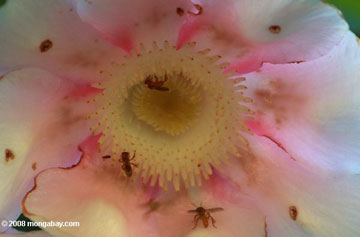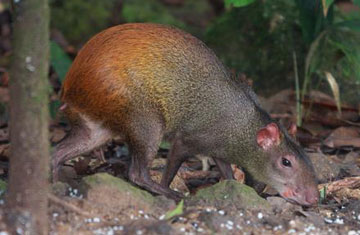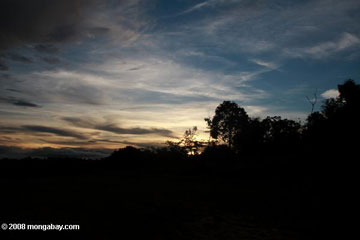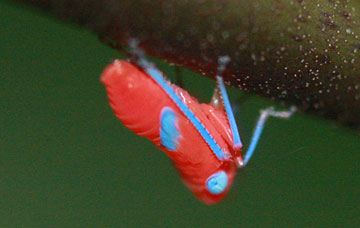Carl Linnaeus’s forgotten apostle rediscovered: an ecological account of 18th Century Suriname
Carl Linnaeus’s forgotten apostle rediscovered: an ecological account of 18th Century Suriname
Jeremy Hance, mongabay.com
August 11, 2008
Daniel Rolander’s diary of his 18th century expedition to Suriname to be published for the first time
|
|
After establishing his ingenious classification system in 1735, Carl Linnaeus, the greatest naturalist of his era, sent young and eager followers to all parts of the world to help him in the goal of collecting and cataloguing the world’s species. It was a project unlike any before; Swedish naturalists, often referred to as Linnaeus’s apostles, roamed as far as Japan, South America, Australia, and the Arctic with the same goal in mind—describing species according to Linnaeus’s system.
Of the 18 men sent abroad, 10 returned. Almost all those who didn’t succumbed to disease. Those who returned to Europe gained renown, including lucrative and stable positions in academia, yet one of the most promising returned and entered oblivion. It was rumored his expedition had been a failure; he was called a drunk, a coward, even insane.
The diary of naturalist Daniel Rolander’s trek to Suriname, long ignored by science and history, will be published for the first time this fall. Though the volume has been disregarded due to the persistent rumors regarding its author, the few readers of the Suriname Diary are consistently surprised by Rolander’s observatory powers, his ability for apt description, and his relentless commitment to natural history despite continual ill health and trying conditions. According to Dr. James Dobreff, who has spent two years translating the diary, “Every time I read Rolander’s journal, I’m more and more impressed by how entertaining [it is] without avoiding purely scientific descriptions. He has a talent for telling stories and imbedding either entertaining stories amidst his scientific descriptions or vice versa.”
 Bees on a flower in Suriname. Photo by Rhett A. Butler |
Rolander’s journal will be published in English and the original Latin. The English edition is part of the IK Foundation’s 300th celebration of Linnaeus’s birth—including a project to publish all the writings of his wayfaring apostles. Rolander’s 700-page journal has rested for centuries in the botanical library of Denmark’s Natural History Museum.
Dr. Pedro Luís Rodrigues de Moraes, a botanist who has been studying Rolander’s discoveries, told Mongabay.com: “The accurate transcription and translation that have been done by the team led by James Dobreff will certainly draw the attention of the public to the unknown side of Rolander as a scientist.”
James Dobreff is committed to bringing Rolander to the world. Aside from translating his diary, Dobreff has also been “coordinating an effort to produce a volume of scientific commentary including over 40 illustrations based on Rolander’s herbarium.” The English translation of the diary will be available in late fall or early winter from the IK Foundation. It is hoped the original Latin text will be printed in December through an unannounced publisher; the funding for the Latin publication is being supported by a Swedish foundation.
The story of the journal’s publication, more than 250 years after Rolander’s expedition, is only a part of his incredible story.
Daniel Rolander’s life: From promising beginnings to obscurity
Educated under Linnaeus himself at the University of Uppsala, Rolander must have impressed his teacher, for he was hired as a tutor for Linnaeus’s son. As a young and ambitious entomologist, Rolander was an excellent choice to serve as one of Linnaeus’s biological ambassadors to distant lands. Fortune intervened when a Dutch plantation owner from Suriname visited Linnaeus looking for a tutor: Rolander was the obvious choice.
In 1755, after a nearly fatal illness, Rolander embarked for distant Suriname ostensibly to tutor the plantation owner’s children, but more importantly to collect samples of plants, insects, and animals in this little-known corner of the world.
Dutch colonies had existed in Suriname for nearly a century, yet the nation’s rich tropics were generally a mystery to science. However, Rolander would not be the first naturalist in Suriname: Maria Sybilla Merian, a fascinating subject herself, spent three years in South America’s smallest nation studying its wildlife 50 years before Rolander.
Although Rolander was criticized and ignored after his return to Europe, his journal vindicates the man, Dobreff says. Rolander shows a “complete dedication to the pursuit of natural history. A nearly fatal fever in Amsterdam, just prior to leaving for Suriname, had ruined his health, yet he is out collecting specimens and describing objects six days a week (he rests and reads the bible/goes to church on Sundays). His critics claim that he was a drunk in Suriname, a claim for which there is no evidence in any form. But none of these critics bothered to travel to Copenhagen to read the Diarium; and its location was no secret.”
 Agouti in Suriname |
Moraes, who studies some of the same species Rolander discovered, agrees with Dobreff and further attests to Rolander’s skill as a scientist. “Rolander in his diary proved he was a well-prepared and skilled biologist. His perspicacity and knowledge of the literature available at his time permitted him to recognize correctly several undescribed species, in addition to the others he had also classified usually in agreement to the published works of pre-Linnaean authors, Linnaeus himself, and contemporaries.”
Unlike many scientists of his day, Rolander wrote more than just descriptions of species. The journal contains a wealth of information, including in-depth scientific studies of innumerable species, daily weather reports, and writings about the contemporary political and social situation in the Dutch colony. Painting a colorful and complex picture of contemporary Suriname, his thoughts range from natural history to social sciences to what today would be called anthropology.
“Rolander’s narratives add texture and background to the descriptions,” Dobreff says. Most other exploration reports from this period are little more than lists or classification catalogues of plants and animals observed.” But Rolander “explains in detail how Amerindians and African slaves use plants for medicinal purposes. There are also long sections of ritual celebrations by the slaves and passages describing their battles with European mercenaries.” At the time, the Dutch were at war with maroons—escaped slaves living in the forest. Rolander, disgusted by the treatment of slaves, shows great sympathy for them, at times appearing to side with the maroons.
Rolander spent seven months in Suriname. When he felt that the forest around the plantation had yielded up most of its secrets, he sailed upriver for more expansive studies. He collected at least 83 insects and perhaps as many as 1,000 different species of plants. He became fascinated by the unique biological properties of fireflies and chameleons, both little known to Europe at the time. Reading even a few paragraphs of his work makes one thinks of an 18th century Gerald Durrell, especially when keeping an anteater in his room to study its behavior or making disparaging remarks about the inconsistencies of human nature in relation to the Dutch treatment of slaves.
After seven months, Rolander felt it was time to return to Europe. He was worried about his health and concerned—quite reasonably—that if he didn’t leave soon he would succumb to some tropical disease, as almost half the other apostles did.
It took two and a half months to return to Europe. He spent another five months in Germany, attempting to raise the necessary funds to return to Sweden and Linnaeus with his diary and massive collection. When he finally reached Linnaeus in October, the two men clashed. Linnaeus wanted full access to Rolander’s journal and specimens, but Rolander—probably exhausted, ill, and upset about being left to wait in Germany for five months—refused to hand them over. Their relationship soured. According to one of Linnaeus’s students, Linnaeus became so desperate to see Rolander’s specimens that at one point he broke into Rolander’s apartment and stole samples.
 Sunset in Suriname. |
Linnaeus was not a man to cross, and Rolander found securing work difficult. He lost or abandoned a position as head gardener at a Stockholm hospital and then left for Denmark in 1760. Possibly distraught and frustrated, he sold a portion of his specimens to botanist Christen Friis Rottboell, who published official descriptions of the plants and gained fame for it.
Despite the trouble it caused Rolander, Dobreff believes the wait to finish his Suriname Diary was good for posterity: “Rather than satisfy himself with the quick publication of a catalogue of the plants and animals of Suriname, he spent nine years working on his Diarium. During those years I suspect that he struggled to create an artful balance between the scientific descriptions and the numerous background narrations and entertaining and disturbing digressions. His efforts make his book an easy read that educates without fatiguing the reader.”
After two temporary and poorly paid positions with wealthy supporters, Rolander moved to Lund, Sweden. Broke, he survived off the generosity of friends. He died there in 1793.
Although there is no evidence of Rolander’s being alcoholic, cowardly, or insane, the rumors persisted, probably spurred on by his conflict with Linnaeus and frustrations during his later life. While some may see the latter part of his life as a failure—perhaps not entirely of his own making—the expedition to Suriname certainly was a success, as his diary attests. “The Diarium Surinamicum is the best evidence that Rolander did not fail to investigate Nature in Suriname, in spite of what is said about him,” Moraes says. “His achievements, viz. the records, descriptions and collections of many species, in the relatively short period he stayed in Suriname, are testimony to the diligent and competent work he had done. The fact that he had had a successful expedition is unquestionable, in my point of view. If the diary had been published during his lifetime, I am quite sure that his reputation would be fairly different.”
Dobreff agrees: “Now, I believe, Rolander’s dedication is finally going to come to fruition and bear its long-maturing fruit.”
Scientific and historical importance of Rolander for the 21st Century
One might question whether a naturalist from the 18th century could really tell us anything new regarding the biodiversity and scientific import of Suriname. However, Moraes believes that “it is never too late to unearth hidden or forgotten information about anything,” adding that he has learned “it is always essential to consult the primary sources.”
Dobreff also believes that Rolander’s journal has significant importance in many different fields. “Rolander will be a tremendous aid to biologists, zoologists, sociologists and related scientists working in the field in Suriname. Rolander provides detailed descriptions of plants, insects, birds, and people. He usually includes descriptions of habitats, and the weather is described in detail, including the temperature for every day in Suriname. So our scientists will have a detailed description of numerous plants and animals (including European slave owners, African slaves, Amerindians, and fugitive slaves and fugitive-slave colonies!) to compare with what they encounter today.”
Moraes adds that for social scientists and history buffs the diary’s historical importance is undoubted, “since it is a prime detailed narrative about the Suriname of the 18th century, discoursing on almost everything.”
Unfortunately, Rolander lost his chance to name any of the species he discovered during his expedition. Since the diary was not published when he wrote it, “those plant names (species) will become validly published, but will be illegitimate names, or superfluous names, since they are synonyms of others that have been validly published before,” Moraes explains.
 Treehopper in Suriname. Suriname photos by Rhett A. Butler |
But this does not diminish the scientific import of Rolander’s journal. The book provides a window into a little-known past, allowing biologists a rare chance to compare contemporary Suriname with what Rolander encountered centuries ago. Moraes notes that “Rolander’s precise registers of the environments he explored… are among the first reported. This kind of information is still interesting and important to be compared to the present, since it could be used as a reference to seasonal climatic changes that most likely happened from that time, 1755-56. Additionally, the description given by Rolander of the pristine nature he found in Suriname is also useful for understanding species distribution, frequency (abundant vs. rare species) in the context of what is found nowadays in fragmented and disturbed landscapes.” Even for well-known plant species, Rolander gives “original information on their uses by Surinamese people, or consumption by fauna.” So this 250-year-old manuscript still holds vibrant treasures for contemporary biologists.
It has taken 250 years but it’s hoped that through the publication of Rolander’s journal, a reputation can be rebuilt and a life’s work celebrated. The apostles of Linnaeus were almost all treated as heroes—dead or alive—and rightly so. They traveled far from home, risked their lives, spent years undergoing extreme conditions, all in the name of furthering humanity’s knowledge of the world’s great biodiversity. All were proclaimed heroes, but one. Now, as his voice is finally heard after centuries of silence, historians and scientists can listen to his story and perhaps change their perceptions of a young Swedish entomologist named Daniel Rolander.
For more information, including contributing to commentary on Rolander, contact Dr. James Dobreff at ![]()
Also visit the IK Foundation